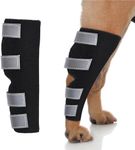Buying Guide for the Best Knee Support For Dogs
When it comes to picking the right knee support for your dog, it's important to consider several factors to ensure that you choose the best product for your furry friend. Knee supports can help with injuries, arthritis, or post-surgery recovery, and the right one can make a significant difference in your dog's comfort and mobility. Here are some key specifications to consider when selecting a knee support for your dog.Size and FitSize and fit are crucial when selecting a knee support for your dog. A well-fitted knee support will provide the necessary stability and comfort. Measure your dog's leg circumference and length according to the manufacturer's guidelines. Sizes typically range from small to extra-large, and it's important to choose one that matches your dog's measurements. A knee support that is too tight can cause discomfort, while one that is too loose may not provide adequate support.
MaterialThe material of the knee support affects both comfort and durability. Common materials include neoprene, which is flexible and provides good support, and breathable fabrics that prevent overheating. Consider your dog's activity level and any skin sensitivities when choosing the material. For active dogs, a durable and flexible material is ideal, while dogs with sensitive skin may benefit from softer, hypoallergenic fabrics.
AdjustabilityAdjustability features, such as straps and Velcro closures, allow you to customize the fit of the knee support. This is important for ensuring that the support stays in place and provides consistent support. Look for knee supports with multiple adjustable points to accommodate changes in your dog's leg size due to swelling or muscle changes. Adjustable supports are particularly useful for growing puppies or dogs undergoing rehabilitation.
Support LevelThe level of support provided by the knee brace can vary. Some braces offer mild support for minor injuries or arthritis, while others provide more rigid support for severe injuries or post-surgery recovery. Consider your dog's specific condition and consult with your veterinarian to determine the appropriate level of support. For mild conditions, a flexible brace may suffice, while more serious issues may require a brace with rigid supports or hinges.
Ease of UseEase of use is an important factor, especially if you need to put the knee support on and take it off frequently. Look for designs that are easy to apply and remove, with clear instructions. Some knee supports have quick-release buckles or simple Velcro straps that make the process straightforward. If your dog is not very cooperative, a design that can be quickly and easily secured will be beneficial.
Hygiene and MaintenanceKnee supports can get dirty, especially if your dog is active outdoors. Consider how easy it is to clean the knee support. Some materials are machine washable, while others may require hand washing. Regular cleaning is important to prevent skin irritation and maintain the brace's effectiveness. Choose a knee support that fits your lifestyle and your willingness to maintain it.


















